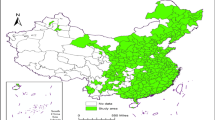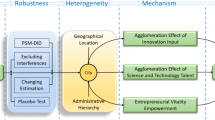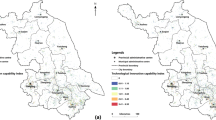Abstract
This study uses green patent data from 264 cities in China between 2006 and 2020 to examine the evolution of spatial patterns in urban green technology innovation (GTI) across the country and identify the underlying driving factors. Moran’s I index, Getis-Ord Gi* index, standard deviation ellipse, and geographical detector were used for the analysis. The findings indicate an increase in the overall level of GTI within Chinese cities. Provincial capitals, cities along the eastern coast, and planned cities emerge as the prominent “highlands” of GTI, whereas the “lowlands” of GTI predominantly lie in the western and northeastern regions, forming the spatial pattern of “hot in the east and center of the country, cold in the northwest and the northeast.” The distribution center of gravity of GTI is toward the southwest of China. The distribution pattern is in the “northeast-southwest” direction, which is characterized by “diffusion,” followed by “agglomeration.” Differences in economic development have the highest determining power on the spatial differentiation of GTI in Chinese cities, whereas differences in environmental regulation and industrial structure have the lowest degree of relative influence. The interaction between any two factors contributes to an amplified explanatory power in understanding the differences in GTI.
Similar content being viewed by others
References
Acemoglu D, Aghion P, Bursztyn L et al., 2012. The environment and directed technical change. American Economic Review, 102(1): 131–166.
Bai J, Jiang F, 2015. Synergy innovation, spatial correlation and regional innovation performance. Economic Research Journal, (7): 174–187. (in Chinese)
Barbera J, McConnell D, 1990. The impact of environmental regulations on industry productivity: Direct and indirect effects. Journal of Environmental Economics and Management, 18(1): 50–65.
Che D, Wu C, Ren X et al., 2020. How does fiscal technology expenditure affect enterprise technology innovation? Heterogeneity, macro-micro mechanism and government incentive structure. China Soft Science, (3): 171–182. (in Chinese)
Chen B, Peng W, Liu Y, 2022. Spatio-temporal evolution and driving factors of green innovation efficiency of the urban agglomeration in the middle reaches of the Yangtze River. Economic Geography, 42(9): 43–49. (in Chinese)
Chen Y, Wang S, 2021. Research on the structure, effects and problems of my country’s fiscal technology expenditure. Scientific Management Research, 39(5): 140–149. (in Chinese)
Chen Y, Xu Y, Wang F, 2022. Air pollution effects of industrial transformation in the Yangtze River Delta from the perspective of spatial spillover. Journal of Geographical Sciences, 32(1): 156–176.
Dong H, Li X, Zhang R, 2021. Spatial-temporal characteristics and driving factors of green innovation efficiency in Guangdong-Hong Kong-Macao Greater Bay Area. Economic Geography, 41(5): 134–144. (in Chinese)
Dong S, Ren G, Xue Y et al., 2023. Urban green innovation’s spatial association networks in China and their mechanisms. Sustainable Cities and Society, 93: 104536.
Dong S, Xue Y, Ren G et al., 2022. Urban green innovation efficiency in China: Spatiotemporal evolution and influencing factors. Land, 12: 75.
Dong Z, Wang H, 2021. Urban wealth and green technology choice. Economic Research Journal, (4): 143–159. (in Chinese)
Driessen P H, Hillebrand B, Kok R et al., 2013. Green new product development: The pivotal role of product greenness. IEEE Transactions on Engineering Management, 60(2): 315–326.
Duan D, Du D, 2022. Green technology innovation in China city system: Dynamics and determinants. Acta Geographica Sinica, 77(12): 3125–3145. (in Chinese)
Fei J, Wang Y, Yang Y et al., 2016. Towards eco-city: The role of green innovation. Energy Procedia, 104: 165–170.
Fussler C, James P, 1996. Eco-innovation: A Breakthrough Discipline for Innovation and Sustainability. London: Pitman Publishing.
Gordon I, McCann P, 2005. Innovation, agglomeration, and regional development. Journal of Economic Geography, 5(5): 523–543.
Gössling T, Rutten R, 2007. Innovation in regions. European Planning Studies, 15: 253–270.
Guo J, Zhou Y, Ali S et al., 2021. Exploring the role of green innovation and investment in energy for environmental quality: An empirical appraisal from provincial data of China. Journal of Environmental Management, 292(1): 112779.
Hall B, Harhoff D, 2012. Recent research on the economics of patents. Annual Review of Economics, 4(1): 541–565.
Hascic I, Migotto M, 2015. Measuring environmental innovation using patent data. OECD Environ Working Papers, No.89. Paris OECD: Publishing.
Hascic I, Silva J, Johnstone N, 2012. Climate mitigation and adaptation in Africa: Evidence from patent data. OECD Environment Working Papers, No.50. Paris: OECD Publishing.
Hascic I, Silva J, Johnstone N, 2015. The use of patent statistics for international comparisons and analysis of narrow technological fields. OECD Science, Technology and Industry Working Papers, No.2015/05. Paris: OECD Publishing.
Jin B, Li G, 2013. Green economic growth from a developmental perspective. China Finance and Economic Review, 1–4.
Kemp R, 2010. Eco-innovation: Definition, measurement and open research issues. Economia Politica, 27(3): 397–420.
Kneller R, Manderson E, 2012. Environmental regulations and innovation activity in UK manufacturing industries. Resource and Energy Economics, 34(2): 211–235.
Lefever D, 1926. Measuring geographic concentration by means of the standard deviational ellipse. American Journal of Sociology, 32(1): 88–94.
Li J, Ma X, 2019. Comparative analysis of the time-space differences and influencing factors of cities green innovation efficiency in Beijing-Tianjin-Hebei. Systems Engineering, 37(5): 51–61. (in Chinese)
Liu B, Wang L, 2020. The impact of spatial mobility of innovation factors on regional innovation capacity: Foreign attraction and local dependence. Seeking Truth, (5): 66–75. (in Chinese)
Liu Y, Wang A, Wu Y, 2021. Environmental regulation and green innovation: Evidence from China’s new environmental protection law. Journal of Cleaner Production, 297: 1–10.
Martinus K, Suzuki J, Bossaghzadeh S, 2020. Agglomeration economies, interregional commuting and innovation in the peripheries. Regional Studies, 54(6): 776–788.
Peng W, Su X, Yang S et al., 2023. Spatio-temporal evolution and spillover effects of urban green innovation under environmental regulation. Scientia Geographica Sinica, 43(1): 41–49. (in Chinese)
Porter M, Linde C, 1995. Towards a new conception of the environment-competitiveness relationship. Journal of Economic Perspectives, 4(4): 97–118.
Rennings K, 2000. Redefining innovation: Eco-innovation research and the contribution from ecological economics. Ecological Economics, 32(2): 319–332.
Shang Y, Wang Z, Mi Z et al., 2021. Structural characteristics and optimization strategies of green technology innovation network in the Yangtze River Delta. Resources and Environment in the Yangtze Basin, 30(9): 2061–2069. (in Chinese)
Shao X, Weng Z, Miao Q et al., 2022. Evolution and element analysis of regional green technology innovation output network: Evidence from the urban agglomeration of the Yangtze River Economic Belt. Geography Geo-information Science, 38(4): 40–49. (in Chinese)
Sun B, Zhang Y, 2022. A research of the distributional dynamic evolution and regional disparities of green innovation index in China. The Journal of Quantitative & Technical Economics, (1): 51–72. (in Chinese)
Sun Y, Shen S, 2021. The spatio-temporal evolutionary pattern and driving forces mechanism of green technology innovation efficiency in the Yangtze River Delta region. Geographical Research, 40(10): 2743–2759. (in Chinese)
Tan F, Gong C, Niu Z, 2022. How does regional integration development affect green innovation? Evidence from China’s major urban agglomerations. Journal of Cleaner Production, 379: 134613.
Tian C, Li X, Xiao L et al., 2022. Exploring the impact of green credit policy on green transformation of heavy polluting industries. Journal of Cleaner Production, 335: 1–12.
Wagner M, 2007. On the relationship between environmental management, environmental innovation and patenting: Evidence from German manufacturing firms. Research Policy, 36(10): 1587–1602.
Wang B, Zhang Y, Chen L et al., 2020. Urban green innovation level and decomposition of its determinants in China. Science Research Management, 41(8): 123–134. (in Chinese)
Wang J, Du G, 2021. The spatial difference and dynamic evolution of green innovation in China’s cities. Chinese Journal of Population Science, (4): 74–85. (in Chinese)
Wang J, Du G, 2021. Spatial association network of green innovation in Chinese cities and its impact effect. China Population, Resources and Environment, 31(5): 21–27. (in Chinese)
Wang J, Xu C, 2017. Geodetector: Principle and prospective. Acta Geographica Sinica, 72(1): 116–134. (in Chinese)
Wang K, Zhang F, Xu R et al., 2023. Spatiotemporal pattern evolution and influencing factors of green innovation efficiency: A China’s city level analysis. Ecological Indicators, 146: 109901.
Wang Y, Cui C, Wang Q et al., 2021. Migration of human capital in the context of vying for talent competition: A case study of China’s “first-class” university graduates. Geographical Research, 40(3): 743–761. (in Chinese)
Wang Y, Yang Y, 2021. Analyzing the green innovation practices based on sustainability performance indicators: A Chinese manufacturing industry case. Environmental Science and Pollution Research, 28: 1181–1203.
Wang Z, Liang L, Wang X, 2021. Spatiotemporal evolution of PM2.5 concentrations in urban agglomerations of China. Journal of Geographical Sciences, 31(6): 878–898.
Wu C, Xu Y, Sun K, 2022. Impact of urban economic agglomeration on green technological innovation: Spatial econometric analysis based on the panel data of 232 prefecture-level cities. Economic Geography, 42(10): 25–34. (in Chinese)
Wu H, Guo H, Zhang B et al., 2017. Westward movement of new polluting firms in China: Pollution reduction mandates and location choice. Journal of Comparative Economics, 45(1): 119–138.
Xi J, 2022. Hold high the great banner of socialism with Chinese characteristics and strive in unity to build a modern socialist country in all respects. http://www.gov.cn/xinwen/2022-10/25/content_5721685.htm.
Yang J, Xu J, Wu X, 2013. Income growth, environmental cost and health problems. Economic Research Journal, (12): 17–29. (in Chinese)
Yu Y, Lyu L, 2023. Spatial pattern of knowledge innovation function among Chinese cities and its influencing factors. Journal of Geographical Sciences, 33(6): 1161–1184.
Yu Y, Xu Z, Shen P et al., 2022. Efficiency evaluation and influencing factors of green innovation in Chinese resource-based cities: Based on SBM-undesirable and spatial Durbin model. International Journal of Environmental Research and Public Health, 19: 13772.
Zhang C, 2019. High-skilled migrants, cultural diversity and urban innovation in China. The Journal of World Economy, (11): 172–192. (in Chinese)
Zhang J, Chen S, 2021. Financial development, environmental regulations and green economic transition. Journal of Finance and Economics, 47(11): 78–93. (in Chinese)
Zhang J, Geng H, Xu G et al., 2019. Research on the influence of environmental regulation on green technology innovation. China Population, Resources and Environment, 29(1): 168–176. (in Chinese)
Zhang K, Li Y, Qi Y et al., 2021. Can green credit policy improve environmental quality? Evidence from China. Journal of Environmental Management, 298: 1–11.
Zhuang Y, Chu Q, Ma Y, 2020. Financial development, firm innovation, and economic growth. Journal of Financial Research, (4): 11–30. (in Chinese)
Author information
Authors and Affiliations
Corresponding author
Additional information
Foundation: National Natural Science Foundation of China, No.42171172; Natural Science Foundation of Guangdong Province, No.2021A1515012248; Major Program of the National Social Science Fund of China, No.21ZDA011
Author: Li Ying (1993–), PhD Candidate, specialized in economic geography and portfolio selection.
Rights and permissions
About this article
Cite this article
Li, Y., Fang, Y. & Meng, Q. Spatial pattern evolution and driving factors of urban green technology innovation in China. J. Geogr. Sci. 34, 289–308 (2024). https://doi.org/10.1007/s11442-024-2205-3
Received:
Accepted:
Published:
Issue Date:
DOI: https://doi.org/10.1007/s11442-024-2205-3




